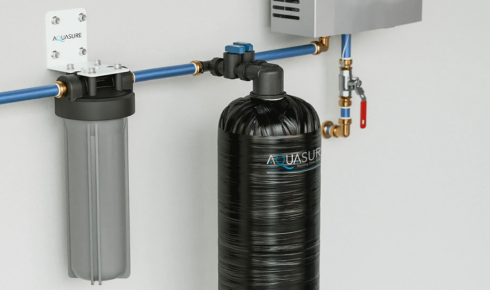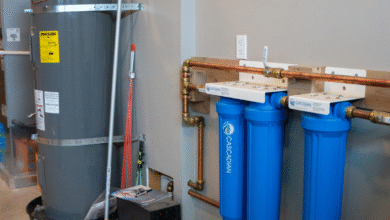Living Without Salt: Why More Homes Are Switching to Smarter Water Solutions

Water is something we rarely stop to think about—until it starts leaving cloudy spots on dishes, roughness in our laundry, or stubborn white buildup around faucets. For years, homeowners were told that the only answer was pouring bags of salt into a bulky water softener. But times are changing, and so are preferences. More people want water that feels good, protects plumbing, and still respects health and the environment. That’s where salt-free alternatives come in, and they’re quietly reshaping how we think about water quality at home.
The Problem with Hard Water
If you’ve ever fought soap scum in the shower or noticed your kettle crusting up faster than it should, you’ve dealt with hard water. It’s not dangerous—plenty of people drink it daily—but it can be annoying and costly. Minerals like calcium and magnesium build up inside pipes, appliances, and fixtures. Over time, this can shorten the life of your washing machine, make heating systems less efficient, and leave you frustrated with stiff laundry and dull hair.
Traditional water softeners do fix the issue, but they do it by swapping calcium and magnesium for sodium. That means constant salt refills, heavy bags to lug home, and in some areas, environmental concerns about salt discharge. Not everyone wants that trade-off.
Enter the Salt-Free Revolution
The new generation of water systems doesn’t rely on salt to “soften” water in the old sense. Instead, they condition it. Using alternative methods—like template-assisted crystallization or catalytic media—these systems prevent minerals from sticking to surfaces, without actually removing them from the water. It’s a shift in thinking: instead of fighting against what’s in the water, they reshape it so it doesn’t cause harm.
And the best part? They’re virtually maintenance-free. No salt bags, no electrical hookups, and no monthly ritual of checking the brine tank. Just install, forget, and enjoy. That simplicity is exactly why demand for a salt free water softener system has skyrocketed over the past few years.
Health and Environmental Benefits
People who are watching their sodium intake appreciate not having extra salt in their water. Even though the amount added by traditional systems is relatively small, health-conscious homeowners often prefer to keep their drinking water as clean and natural as possible.
From an environmental standpoint, salt-free systems also make sense. Some regions have started restricting conventional softeners because of their brine discharge into wastewater. Salt-free conditioners bypass that problem entirely, which makes them especially appealing to eco-minded households.
Everyday Life with Better Water
What’s the actual difference once you make the switch? It’s subtle but noticeable. Glasses come out of the dishwasher clearer. Shower doors stay cleaner longer. Skin feels smoother because soap rinses off more effectively. Towels don’t feel like cardboard after a few washes.
It’s not just about comfort, either. Appliances that use water—dishwashers, water heaters, even coffee makers—run more efficiently when scale can’t build up. That means fewer breakdowns and longer lifespans. For a busy household, that’s not a small perk.
Choosing the Right System for Your Home
Not all salt-free systems are created equal. Some are better suited to whole-house solutions, while others are designed for smaller setups. The trick is knowing what you need. How hard is your water? Do you mainly want to protect appliances, or are you looking for a noticeable difference in showers and laundry too?
A salt-free water conditioner for home can often cover all bases, but it’s worth checking specifications carefully. Flow rate, filtration capability, and installation requirements vary widely between models. Sometimes pairing a conditioner with an additional sediment or carbon filter creates the best results, especially if your water supply carries chlorine or other contaminants.
Why Many Call It the “Best” Choice
Homeowners who’ve made the leap rarely look back. Reviews often sound like a sigh of relief: no more salt trips, no more guilt about brine waste, just clean and reliable water. When you factor in long-term costs—since there are no recurring salt or electricity expenses—the value becomes clear too.
For families balancing practicality and eco-consciousness, a best salt free water conditioner isn’t just a gadget; it feels like a lifestyle upgrade. It’s one of those changes you hardly notice day-to-day, but the benefits add up quietly in the background—less hassle, more peace of mind.
The Bigger Picture: A Shift in Priorities
What this trend really shows is a broader change in how people approach home solutions. It’s no longer just about fixing a problem at any cost. More homeowners are asking: how does this affect health, sustainability, convenience, and the planet? Salt-free systems tick multiple boxes, which is why they’re gaining ground even in areas where traditional softeners were once considered the only option.
Think about it: we’re all juggling busy lives, trying to make smarter choices without overcomplicating things. Nobody wants to spend their weekend dealing with salt bags or worrying about hidden environmental impacts. The appeal of a low-maintenance, eco-friendly alternative is obvious.
A Practical Step Toward Better Living
At the end of the day, water is personal. We drink it, bathe in it, wash our clothes with it—it’s part of nearly every routine. So it makes sense to want the best possible experience. Going salt-free isn’t about chasing the latest trend; it’s about aligning with a lifestyle that values simplicity, wellness, and responsibility.
If you’ve been on the fence, maybe now’s the time to explore your options. A salt-free system isn’t magic—it won’t turn your tap into a mountain spring—but it can make life at home a little easier, a little healthier, and a lot more sustainable. And honestly, that feels like a win worth raising a glass of clear, clean water to.



